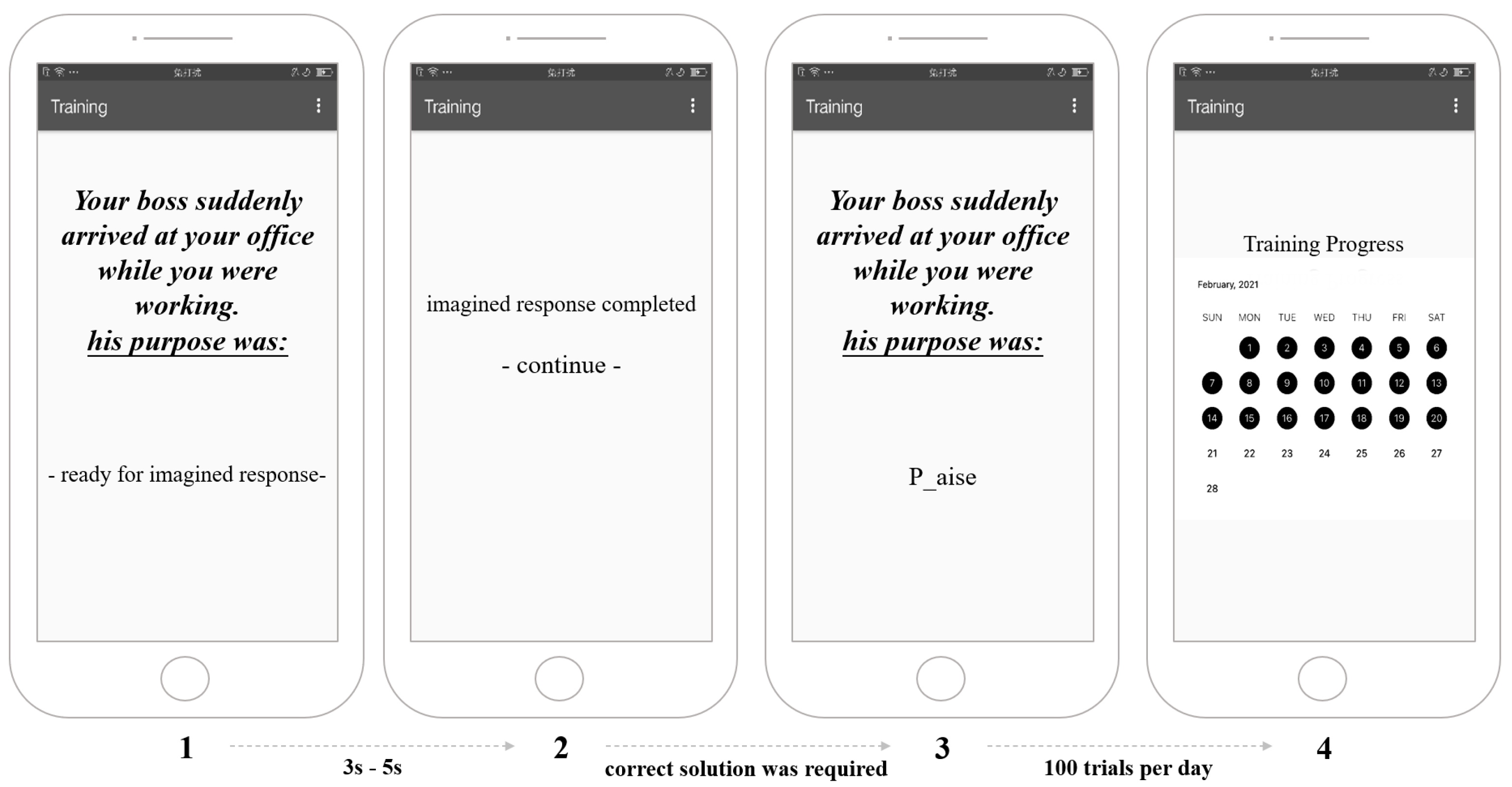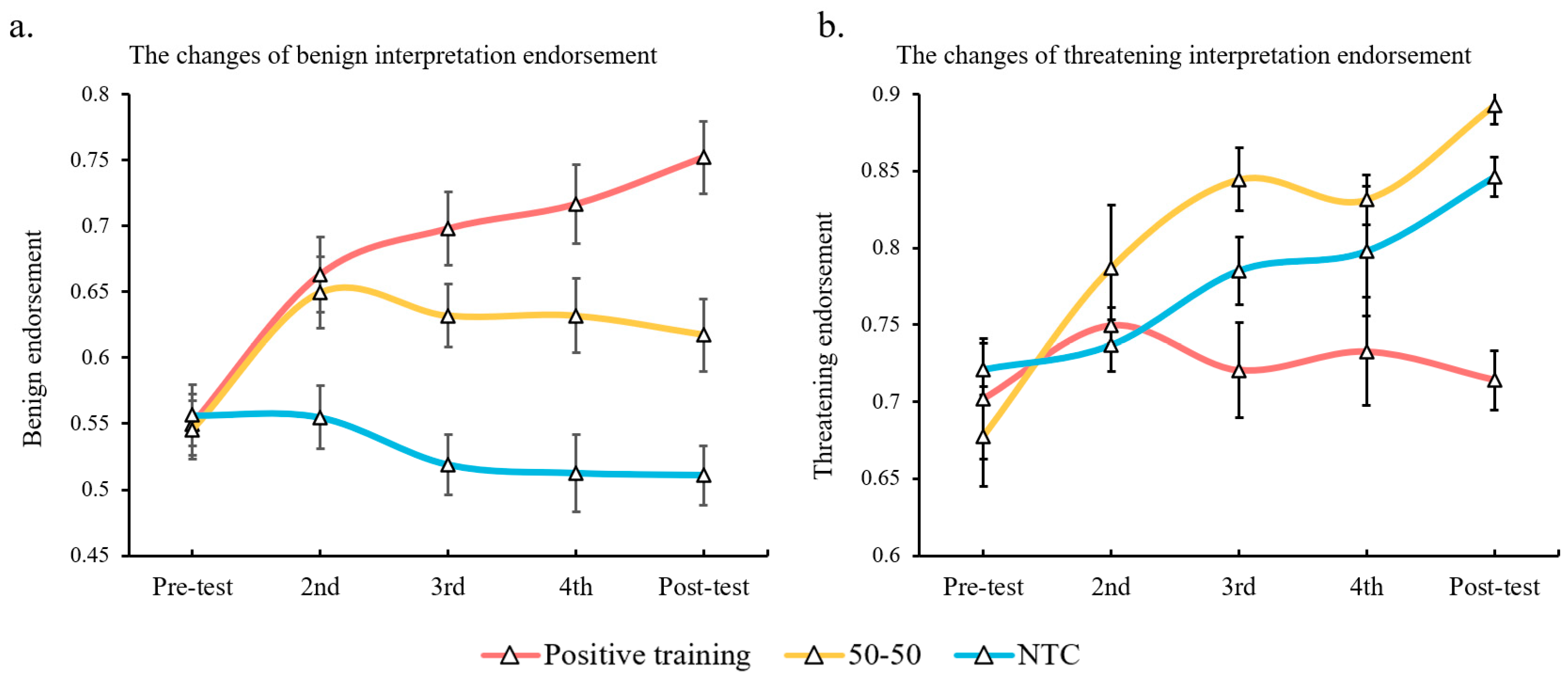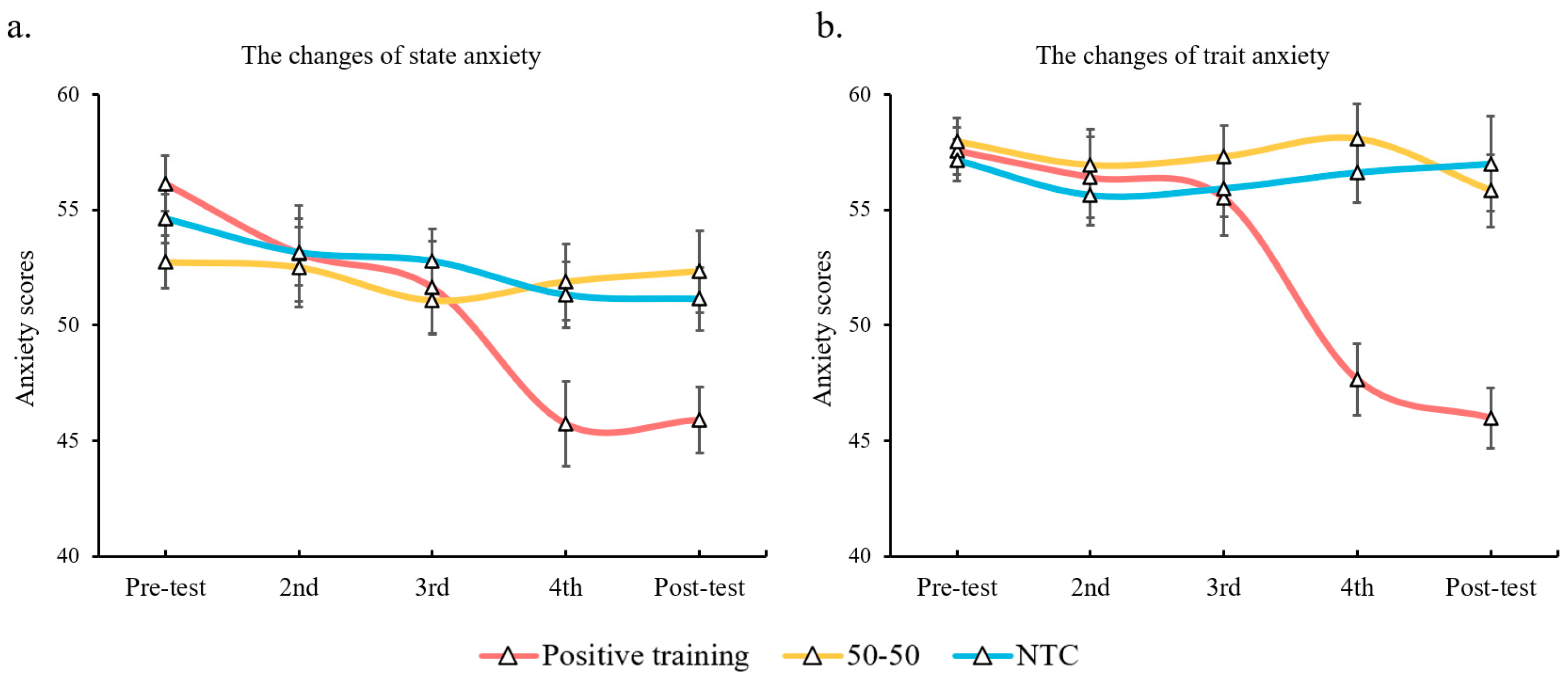Effects of a Smartphone-Based, Multisession Interpretation-Bias Modification for Anxiety: Positive Intervention Effects and Low Attrition
Abstract
1. Introduction
2. Materials and Methods
2.1. Participants
2.2. Materials
2.2.1. Intervention Task Stimuli
2.2.2. Smartphone-Based Intervention Task
2.2.3. Interpretation Bias Measures
2.2.4. Anxiety Level Measures
2.3. Procedure
2.4. Statistical Analysis Plan
3. Results
3.1. Changes in Interpretation Bias
3.1.1. WSAP Task
3.1.2. Interpretation Questionnaire
3.2. Anxiety
3.3. Follow-Up Assessment
3.3.1. Changes in Interpretation Bias
3.3.2. Anxiety
3.4. The Mediation Analysis
4. Discussion
5. Conclusions
Author Contributions
Funding
Institutional Review Board Statement
Informed Consent Statement
Data Availability Statement
Acknowledgments
Conflicts of Interest
References
- Huang, Y.; Wang, Y.; Wang, H.; Liu, Z.; Yu, X.; Yan, J.; Yu, Y.; Kou, C.; Xu, X.; Lu, J.; et al. Prevalence of Mental Disorders in China: A Cross-sectional Epidemiological Study. Lancet Psychiatry 2019, 6, 211–224. [Google Scholar] [CrossRef]
- American Psychiatric Association. Diagnostic and Statistical Manual of Mental Disorders (DSM-5®); American Psychiatric Association: Arlington, VA, USA, 2013. [Google Scholar]
- Ji, J.L.; Baee, S.; Zhang, D.; Calicho-Mamani, C.P.; Meyer, M.J.; Funk, D.; Portnow, S.; Barnes, L.; Teachman, B.A. Multi-session Online Interpretation Bias Training for Anxiety in a Community Sample. Behav. Res. Ther. 2021, 142, 103864. [Google Scholar] [CrossRef] [PubMed]
- Koster, E.H.; Fox, E.; MacLeod, C. Introduction to the Special Section on Cognitive Bias Modification in Emotional Disorders. J. Abnorm. Psychol. 2009, 118, 1–4. [Google Scholar] [CrossRef] [PubMed]
- Muris, P.; Field, A.P. Distorted Cognition and Pathological Anxiety in Children and Adolescents. Cogn. Emot. 2008, 22, 395–421. [Google Scholar] [CrossRef]
- Grey, S.; Mathews, A. Effects of Training on Interpretation of Emotional Ambiguity. Q. J. Exp. Psychol. Sect. A 2000, 53, 1143–1162. [Google Scholar] [CrossRef] [PubMed]
- Wilson, E.J.; MacLeod, C.; Mathews, A.; Rutherford, E.M. The Causal Role of Interpretive Bias in Anxiety Reactivity. J. Abnorm. Psychol. 2006, 115, 103–111. [Google Scholar] [CrossRef] [PubMed]
- Mathews, A.; Mackintosh, B. Induced Emotional Interpretation Bias and Anxiety. J. Abnorm. Psychol. 2000, 109, 602–615. [Google Scholar] [CrossRef]
- Amir, N.; Bomyea, J.; Beard, C. The Effect of Single-session Interpretation Modification on Attention Bias in Socially Anxious Individuals. J. Anxiety Disord. 2010, 24, 178–182. [Google Scholar] [CrossRef]
- Brettschneider, M.; Neumann., P.; Berger., T.; Renneberg., B.; Boettcher, J. Internet-based Interpretation Bias Modification for Social Anxiety: A Pilot Study. J. Behav. Ther. Exp. Psychiatry 2015, 49, 21–29. [Google Scholar] [CrossRef]
- Clerkin, E.M.; Magee, J.C.; Parsons, E.M. Evaluating Change in Beliefs about the Importance/Control of Thoughts as a Mediator of CBM-I and Responses to an ICT Stressor. J. Obs. -Compuls. Relat. Disord. 2014, 3, 311–318. [Google Scholar] [CrossRef]
- Samie Fard, M.; Salehi Fadardi, J. The Effectiveness of a Cognitive Bias Modification–Interpretation (CBM-I) on Reducing Frustration related to Negative Interpretation Bias and its Outcomes for Indices of Substance Abuse Behaviors. The First International Congress of Alcohol Abuse. 2014. Available online: https://profdoc.um.ac.ir/paper-abstract-1052966.html (accessed on 23 January 2023).
- Price, M.; Yuen, E.K.; Goetter, E.M.; Herbert, J.D.; Forman, E.M.; Acierno, R.; Ruggiero, K.J. mHealth: A Mechanism to Deliver More Accessible, More Effective Mental Health Care. Clin. Psychol. Psychother. 2013, 21, 427–436. [Google Scholar] [CrossRef]
- Carl, J.R.; Miller, C.B.; Henry, A.L.; Davis, M.L.; Stott, R.; Smits, J.A.J.; Emsley, R.; Gu, J.; Shin, O.; Otto, M.W.; et al. Efficacy of Digital Cognitive Behavioral Therapy for Moderate-to-severe Symptoms of Generalized Anxiety Disorder: A Randomized Controlled Trial. Depress. Anxiety 2020, 37, 1168–1178. [Google Scholar] [CrossRef]
- Purkayastha, S.; Addepally, S.A.; Bucher, S. Engagement and Usability of a Cognitive Behavioral Therapy Mobile App Compared With Web-Based Cognitive Behavioral Therapy Among College Students: Randomized Heuristic Trial. JMIR Hum. Factors 2020, 7, e14146. [Google Scholar] [CrossRef]
- Yang, R.; Cui, L.; Li, F.; Xiao, J.; Zhang, Q.; Oei, T.P.S. Effects of Cognitive Bias Modification Training via Smartphones. Front. Psychol. 2017, 8, 1370. [Google Scholar] [CrossRef]
- Zhang, M.; Ying, J.B.; Song, G.; Fung, D.S.; Smith, H. Attention and Cognitive Bias Modification apps: Review of the Literature and of Commercially Available apps. JMIR Mhealth Uhealth 2018, 6, e10034. [Google Scholar] [CrossRef]
- Sun, X.; Yang, R.; Zhang, Q.; Xiao, J.; Cui, L. Cognitive Bias Modification for Interpretation Training via Smartphones for Social Anxiety in Chinese Undergraduates. J. Exp. Psychopathol. 2019, 10, 204380871987527. [Google Scholar] [CrossRef]
- Wu, A.; Scult, M.A.; Barnes, E.D.; Betancourt, J.A.; Gunning, F.M. Smartphone apps for Depression and Anxiety: A Systematic Review and Meta-Analysis of Techniques to Increase Engagement. npj Digit. Med. 2021, 4, 20. [Google Scholar] [CrossRef]
- Salemink, E.; van den Hout, M.; Kindt, M. How does Cognitive Bias Modification Affect Anxiety? Mediation Analyses and Experimental Data. Behav. Cogn. Psychother. 2010, 38, 59–66. [Google Scholar] [CrossRef]
- Beard, C.; Amir, N. A Multi-session Interpretation Modification Program: Changes in Interpretation and Social Anxiety Symptoms. Behav. Res. Ther. 2008, 46, 1135–1141. [Google Scholar] [CrossRef]
- Stopa, L.; Clark, D.M. Social Phobia and Interpretation of Social Events. Behav. Res. Ther. 2000, 38, 273–283. [Google Scholar] [CrossRef]
- Beck, A.T.; Clark, D.A. An Information Processing Model of Anxiety: Automatic and Strategic Processes. Behav. Res. Ther. 1997, 35, 49–58. [Google Scholar] [CrossRef]
- Tran, T.B.; Hertel, P.T.; Joormann, J. Cognitive Bias Modification: Induced Interpretive Biases Affect Memory. Emotion 2011, 11, 145–152. [Google Scholar] [CrossRef]
- Hirsch, C.R.; Mathews, A.; Clark, D.M. Inducing an Interpretation Bias Changes Self-imagery: A Preliminary Investigation. Behav. Res. Ther. 2007, 45, 2173–2181. [Google Scholar] [CrossRef]
- Giannini, M.; Loscalzo, Y. Social Anxiety and Adolescence: Interpretation Bias in an Italian Sample. Scand. J. Psychol. 2016, 57, 65–72. [Google Scholar] [CrossRef]
- Loscalzo, Y.; Giannini, M.; Miers, A.C. Social Anxiety and Interpretation Bias: Examining Clinical and Subclinical Components in Adolescents. Child Adolesc. Ment. Health 2018, 23, 169–176. [Google Scholar] [CrossRef]
- Shek, D.T. The Chinese Version of the State-Trait Anxiety Inventory: Its Relationship to Different measures of Psychological Well-being. J. Clin. Psychol. 1993, 49, 349–358. [Google Scholar] [CrossRef]
- Spielberger, C.; Gorsuch, R.; Lushene, R.; Vagg, P.; Jacobs, G. Manual for the State-Trait Anxiety Inventory (Form Y1–Y2); Consulting Psychologists Press: Palo Alto, CA, USA, 1983; Volume IV. [Google Scholar]
- Pan, D.N.; Hoid, D.; Wang, X.B.; Jia, Z.; Li, X. When Expanding Training from Working Memory to Emotional Working Memory: Not only Improving Explicit Emotion Regulation But also Implicit Negative Control for Anxious Individuals. Psychol. Med. 2020, 52, 675–684. [Google Scholar] [CrossRef]
- Claudia, M.L.; Wolfgang, V.; Petra, H.H.; Zuzana, K.; Haller, S.P.; Marjan, D.; Jim, V.O.; Marieke, W.; Lau, J.Y.F.; Martin, V. How to Boost Positive Interpretations? A Meta-Analysis of the Effectiveness of Cognitive Bias Modification for Interpretation. PLoS ONE 2014, 9, e100925. [Google Scholar] [CrossRef]
- Voncken, M.J.; Bogels, S.M.; de Vries, K. Interpretation and Judgmental Biases in Social Phobia. Behav. Res. Ther. 2003, 41, 1481–1488. [Google Scholar] [CrossRef]
- Butler, G.; Mathews, A. Cognitive Processes in Anxiety. Adv. Behav. Res. Ther. 1983, 5, 51–62. [Google Scholar] [CrossRef]
- Li, W.; Qian, M. Revision of the State-Trait Anxiety Inventory with Sample of Chinese College Students. Acta Sci. Nat. Univ. Pekin. 1995, 31, 108–114. [Google Scholar]
- The Jamovi Project Jamovi 2.3. 2022. Available online: https://www.jamovi.org (accessed on 23 January 2023).
- Salemink, E.; Hertel, P.; Mackintosh, B. Interpretation Training Influences Memory for Prior Interpretations. Emotion 2010, 10, 903–907. [Google Scholar] [CrossRef]
- Sakaki, K.; Nozawa, T.; Ikeda, S.; Kawashima, R. Neural Correlates of Cognitive Bias Modification for Interpretation. Soc. Cogn. Affect. Neurosci. 2020, 15, 247–260. [Google Scholar] [CrossRef]
- Hallion, L.S.; Ruscio, A.M. A Meta-analysis of the Effect of Cognitive Bias Modification on Anxiety and Depression. Psychol. Bull. 2011, 137, 940–958. [Google Scholar] [CrossRef]
- Hirsch, C.R.; Hayes, S.; Mathews, A. Looking on the Bright Side: Accessing Benign Meanings Reduces Worry. J. Abnorm. Psychol. 2009, 118, 44–54. [Google Scholar] [CrossRef]
- Spitzer, R.L.; Kroenke, K.; Williams, J.B.W.; Löwe, B. A Brief Measure for Assessing Generalized Anxiety Disorder: The GAD-7. Arch. Intern. Med. 2006, 166, 1092–1097. [Google Scholar] [CrossRef]
- Veloso, G.C.; Ty, W. The Effects of Emotional Working Memory Training on Trait Anxiety. Front. Psychol. 2021, 11, 549623. [Google Scholar] [CrossRef]
- Liu, B.; Wang, Y.; Li, X. Implicit Emotion Regulation Deficits in Trait Anxiety: An ERP Study. Front. Hum. Neurosci. 2018, 12, 382. [Google Scholar] [CrossRef]
- Dias Lopes, L.F.; Chaves, B.M.; Fabrício, A.; Porto, A.; Machado de Almeida, D.; Obregon, S.L.; Pimentel Lima, M.; Vieira da Silva, W.; Camargo, M.E.; da Veiga, C.P. Analysis of Well-being and Anxiety among University Students. Int. J. Environ. Res. Public Health 2020, 17, 3874. [Google Scholar] [CrossRef]
- Everaert, J.; Grahek, I.; Duyck, W.; Buelens, J.; Nathan, V.; Koster, E. Mapping the Interplay among Cognitive Biases, Emotion Regulation, and Depressive Symptoms. Cogn. Emot. 2016, 1, 726–735. [Google Scholar] [CrossRef]
- Ball, T.M.; Ramsawh, H.J.; Campbell-Sills, L.; Paulus, M.P.; Stein, M.B. Prefrontal Dysfunction during Emotion Regulation in Generalized Anxiety and Panic Disorders. Psychol. Med. 2013, 43, 1475–1486. [Google Scholar] [CrossRef]






| Positive Training (n = 34) | 50-50 (n = 31) | NTC (n = 29) | F/χ2 | p-Value | |
|---|---|---|---|---|---|
| Age (years) | 22.4 (2.09) | 21.8 (1.92) | 22.9 (1.33) | 2.68 | 0.07 |
| Gender (male%) | 24% | 23% | 24% | 0.02 | 0.99 |
| Education (years) | 14.9 (1.84) | 14.5 (1.65) | 15.4 (1.08) | 2.26 | 0.11 |
| Anxiety scores | 57.6 (6.13) | 58 (5.67) | 57.1 (4.92) | 0.16 | 0.85 |
| Repeated Measures ANOVAs | Main Effect (p-Value) | Interaction (p-Value) | ||
|---|---|---|---|---|
| Time | Group | Time × Group | ||
| Interpretation Bias | ||||
| Benign endorsement | 0.446 | <0.001 | Positive > 50-50; Positive > No-training control; 50-50 > No-training control | 0.775 |
| Threatening endorsement | 0.449 | <0.001 | Positive < 50-50; Positive < No-training control | 0.265 |
| Number | 0.459 | <0.001 | Positive < 50-50; Positive < No-training control | 0.375 |
| Rank | 0.616 | <0.001 | Positive > 50-50; Positive > No-training control | 0.421 |
| Belief | 0.899 | <0.001 | Positive < 50-50; Positive < No-training control | 0.116 |
| Anxiety | ||||
| State anxiety | 0.028 | <0.001 | Positive < 50-50; Positive < No-training control; post-test < follow-up | 0.619 |
| Trait anxiety | 0.116 | <0.001 | Positive < 50-50; Positive < No-training control | 0.704 |
| The Group Assignment to Mediators | ||||
|---|---|---|---|---|
| Coeff | Se | t | p | |
| Benign interpretation Endorsement | −0.124 | 0.021 | 5.863 | <0.001 |
| Threatening interpretation Endorsement | 0.061 | 0.233 | 2.6 | 0.011 |
| Negative rank Interpretations | −0.207 | 0.463 | −4.46 | <0.001 |
| Belief about negative interpretations | 0.36 | 0.203 | 1.772 | 0.08 |
| Number of negative interpretations | 1.655 | 0.519 | 3.187 | 0.002 |
| Direct effects of mediators on anxiety | ||||
| Coeff | Se | t | p | |
| Benign interpretation Endorsement | 5.085 | 5.768 | 0.882 | 0.3804 |
| Threatening interpretation Endorsement | −2.712 | 5.668 | −0.479 | 0.634 |
| Negative rank Interpretations | −2.491 | 2.867 | −0.869 | 0.3872 |
| Belief about negative interpretations | 1.151 | 0.643 | 1.79 | 0.077 |
| Number of negative interpretations | 0.484 | 1.502 | 3.125 | <0.001 |
| Total effect of the group assignment on anxiety | ||||
| Effect | Se | t | p | |
| 5.63 | 1.2 | 4.7 | <0.001 | |
| Direct effect of the group assignment on anxiety | ||||
| Effect | Se | t | p | |
| 4.696 | 1.502 | 3.125 | 0.002 | |
| Indirect effect through proposed mediators | ||||
| Effect | BootSe | LLCI | ULCI | |
| Benign interpretation Endorsement | −0.632 | 0.801 | −2.227 | 0.976 |
| Threatening interpretation Endorsement | −0.164 | 0.317 | −0.792 | 0.513 |
| Negative rank Interpretations | 0.514 | 0.682 | −0.88 | 1.852 |
| Belief about negative interpretations | 0.414 | 0.319 | −0.784 | 1.162 |
| Number of negative interpretations | 0.802 | 0.481 | 0.039 | 1.9 |
Disclaimer/Publisher’s Note: The statements, opinions and data contained in all publications are solely those of the individual author(s) and contributor(s) and not of MDPI and/or the editor(s). MDPI and/or the editor(s) disclaim responsibility for any injury to people or property resulting from any ideas, methods, instructions or products referred to in the content. |
© 2023 by the authors. Licensee MDPI, Basel, Switzerland. This article is an open access article distributed under the terms and conditions of the Creative Commons Attribution (CC BY) license (https://creativecommons.org/licenses/by/4.0/).
Share and Cite
Hoid, D.; Pan, D.-N.; Liao, C.; Li, X. Effects of a Smartphone-Based, Multisession Interpretation-Bias Modification for Anxiety: Positive Intervention Effects and Low Attrition. Int. J. Environ. Res. Public Health 2023, 20, 2270. https://doi.org/10.3390/ijerph20032270
Hoid D, Pan D-N, Liao C, Li X. Effects of a Smartphone-Based, Multisession Interpretation-Bias Modification for Anxiety: Positive Intervention Effects and Low Attrition. International Journal of Environmental Research and Public Health. 2023; 20(3):2270. https://doi.org/10.3390/ijerph20032270
Chicago/Turabian StyleHoid, Delhii, Dong-Ni Pan, Chun Liao, and Xuebing Li. 2023. "Effects of a Smartphone-Based, Multisession Interpretation-Bias Modification for Anxiety: Positive Intervention Effects and Low Attrition" International Journal of Environmental Research and Public Health 20, no. 3: 2270. https://doi.org/10.3390/ijerph20032270
APA StyleHoid, D., Pan, D.-N., Liao, C., & Li, X. (2023). Effects of a Smartphone-Based, Multisession Interpretation-Bias Modification for Anxiety: Positive Intervention Effects and Low Attrition. International Journal of Environmental Research and Public Health, 20(3), 2270. https://doi.org/10.3390/ijerph20032270






